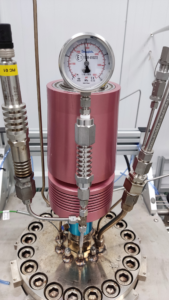Industrial reactors are containers designed to ensure that the substances are in proper contact with each other so that they are correctly modified, controlling that the pressure, temperature and speed conditions necessary to obtain the expected reaction are maintained.
An example of a reactor is the pilot plant of the Life Superbiodiesel project, where the transesterfication reaction is developed under supercritical conditions with a new catalytic methodology, which allows the reactor to operate in slightly less severe conditions for which a specific adaptation is required.
However, can the reactors be modified to cope with the supercritical conditions, without restricting the process and facilitating its replication in any biodiesel production plant?
At the end of March, the working pressure was reached in the supercritical reactor with support system for heterogeneous catalysts, designed and assembled by the AIJU team, making the pilot plant of the Life Superbiodiesel project an ever-closer reality.
Currently, the risk analysis of the process (Hazop analysis) has been carried out and the corresponding operational tests are being planned and executed.
In addition, the part of the pilot plant intended for obtaining biostimulants has already produced the first product samples which, after being analysed, are reproducing the conditions previously obtained at laboratory scale.







Comments are closed.